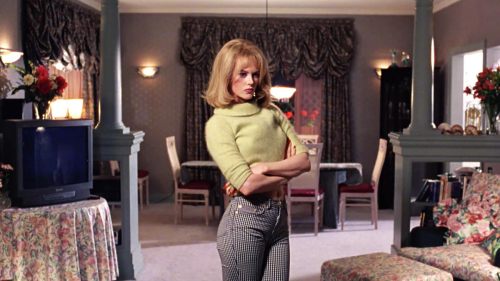Broad Cinema: The Pain And Pleasure Of MOULIN ROUGE!
From Alice Guy-Blaché to Ava Duvernay, women have been integral to cinema for the last 120 years. Broad Cinema is a new column that will feature women who worked on films that are playing this month at the Alamo Drafthouse. From movie stars to directors, from cinematographers to key grips, Broad Cinema will shine a spotlight on women in every level of motion picture production throughout history.
This week we are celebrating Nicole Kidman in Moulin Rouge! Get your tickets here!
There’s a strange thing that musical theatre kids, like myself, do. Sometimes we will turn modern day pop songs into large musical ballads. No one told us to do that, but it’s like we have a funnel through which music permeates our brains. Lucky for us, Baz Luhrmann’s Moulin Rouge (2001) did a lot of the work for us. The film’s score was a genius concoction of established and original songs. And when trying to sum up Luhrman’s works, the word “grand” is not hyperbole. His sets, costumes and musical numbers are larger than life and pull the audience into a fantastical world that sometimes mirrors the real world. While Moulin Rouge appears to be a beautiful, fun musical (which it certainly is), there are a multitude of themes that can easily get swept under the rug in the midst of the fantasia.
Moulin Rouge is obviously aesthetically pleasing, but things that make it beautiful, like costumes, work to reinforce the gender themes of the cast, specifically Nicole Kidman's Satine. In a famous scene, Satine askes “What’s his type? Wilting flower, bright and bubbly or smoldering temptress?”. She changes and shows these different fetishes and it is evident that she can pull all of them off. It is imperative that she shows the fantasy of female, the fetishes to which men succumb; but showing a baseline female projection is of no interest. The heightened masquerade for which Satine operates is necessary for her job, but it comes at the detriment of her health and livelihood. The scene in which she is trying on different styles sets up her character as a placeholder, or a hanger, for the clothing. It’s the image that is important, not the person residing in the clothing.
In Kidman’s famous “Diamonds’ Are A Girls Best Friend” number, the costuming is particularly interesting. The hall is full of men waiting to see the feminine spectacle that is Satine. She repels down from a ceiling dripping in jewels but wearing something noticeable: a top hat. Very rarely is Satine in control of her life, but when she is performing she controls the audience. And to dominate the audience, she wears a male piece of clothing. That might seem like an irrelevant prop, but it exposes the flow of power. When she is working doing her supposed “female duties”, she is expected to be a hyper version of femininity. But when she is flexing her power and commanding the crowd’s attention, the role that is usually left for a man, she dresses the part in a quasi-androgynous ensemble.
Corsets were the normal garb for women at that time and it’s a staple for Satine’s ensemble, as well as that of the chorus. The garment represents the restrictions that are put on women to be appealing to men, or even a fetishized version of a woman. Many feminist articles have been written about this undergarment and much can be said about its significance. But, pertaining to Satine, it represents the physical chains that bind her. The corset is used to make her sexy and desirable, but it binds her to a life that is out of her control. Mirroring her character, in a sense, Nicole Kidman cracked a rib while on set because of the corset. Life certainly did imitate art when the attempt to create a thing of beauty caused physical pain.
The injury that Kidman endured was not the only thing she would share with her character. Moulin Rouge was released in 2001 and if we all look back on our pop culture timeline we will notice that this was the same year Kidman went through her divorce from Tom Cruise. She certainly did forge an acting career of her own, but she was still wildly recognized for her marriage. The role of Satine was a break out for her as she revealed a musical side that her audience had not seen. And she was also stepping out of the shadow of Cruise. Much like Satine, she was a caged bird attempting to fly free. And that is exactly what she achieved in this role.
Moulin Rouge is a film that at first glance can be reduced to a fun movie experience. But upon looking further you will see many disturbing themes that reinforce gender stereotypes and patriarchal norms. As an audience member, it is easy to get caught up in the glamour of the film and oversee the pain of the role of women like Satine. Much like the men who oversee her humanity, we as an audience oversee her plight. The genuine beauty of the film is the representation of the marriage between pain and pleasure. Beauty can be a conduit of pain and out of pain, beauty can form.



